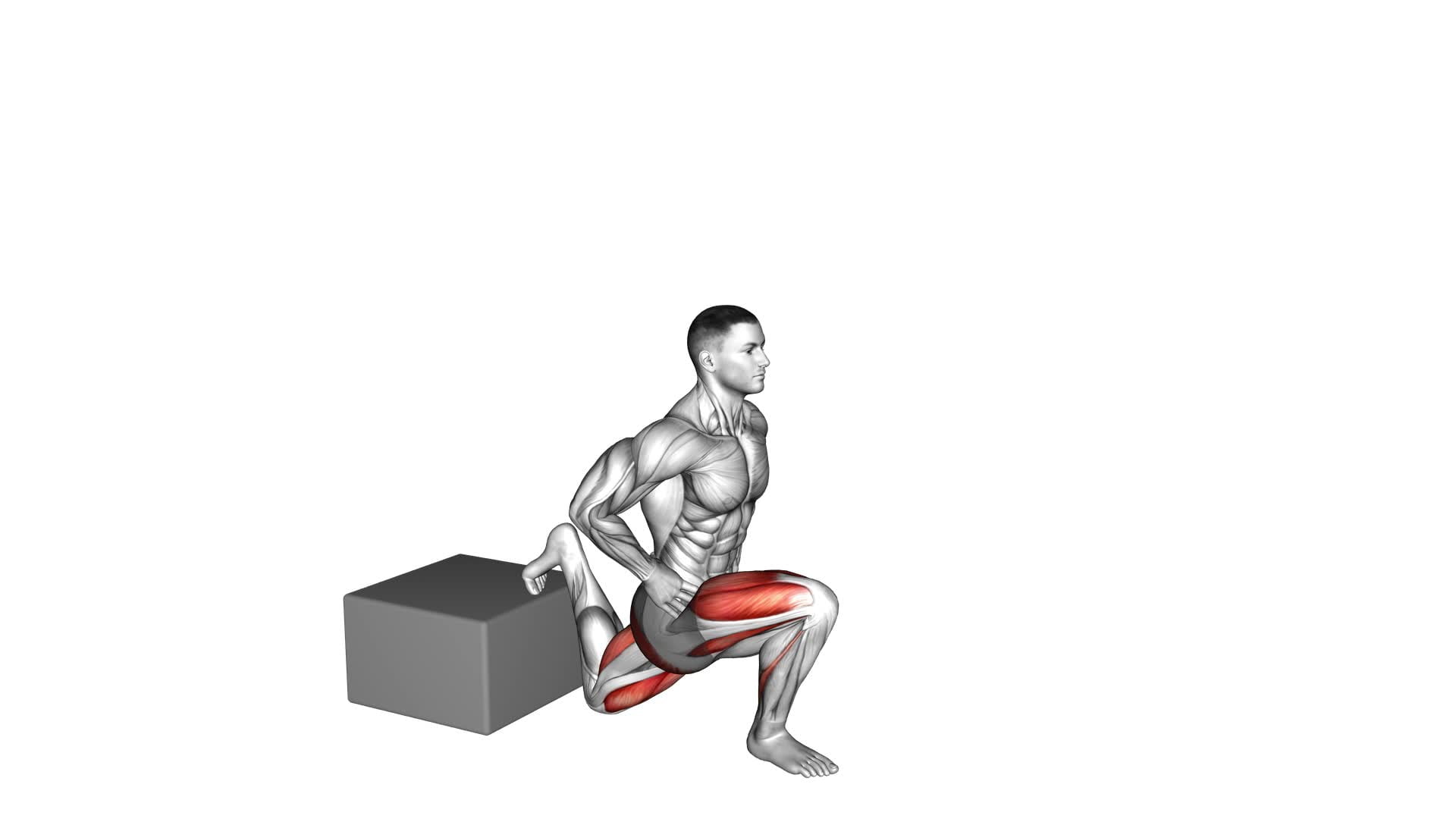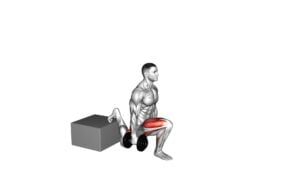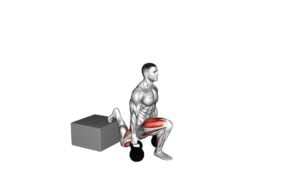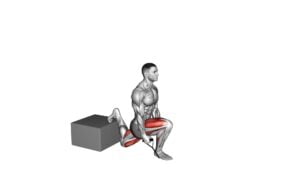Split Squat With Low Box – Video Exercise Guide & Tips

Are you looking to level up your lower body workout? Look no further than the split squat with low box.
Watch This Exercise Video
This exercise targets your glutes, quads, and hamstrings while improving your balance and stability.
In this video exercise guide, you'll learn the proper form and technique, variations and progressions, common mistakes to avoid, and tips for maximizing your workout.
Get ready to take your leg day to the next level with this challenging and effective exercise.
Key Takeaways
- The split squat with low box targets and strengthens glutes, quads, and hamstrings.
- It improves stability, balance, and athletic performance while preventing injuries.
- Proper foot placement on the low box is important for stability and balance.
- Engaging the core throughout the movement is crucial for proper form and stability.
Benefits of the Split Squat With Low Box
One of the benefits of performing the Split Squat With Low Box is that it targets and strengthens your glutes, quads, and hamstrings. This exercise is particularly effective in maximizing results and preventing injuries.
By incorporating the low box into the split squat, you're able to increase the range of motion and engage more muscle groups. This not only leads to better muscle activation but also helps in developing stability and balance.
The glutes, quads, and hamstrings are key muscles involved in lower body movements and are essential for activities like walking, running, and jumping. Strengthening these muscles can improve your overall athletic performance and help prevent injuries such as strains and sprains.
Additionally, the Split Squat With Low Box is a unilateral exercise, meaning it focuses on one leg at a time. This helps in identifying and correcting any strength imbalances between your left and right side. By addressing these imbalances, you can reduce the risk of compensatory movements and further injury.
Proper Form and Technique
When performing the split squat with a low box, proper form and technique are essential for maximizing the benefits of the exercise and avoiding injury.
One key point to focus on is foot placement, as it can impact your stability and balance throughout the movement.
Engaging your core muscles throughout the exercise is also crucial for maintaining proper form and stability.
Lastly, it's important to be mindful of any knee pain and make adjustments to your form or range of motion as needed to prevent discomfort.
Foot Placement Importance
Ensure proper foot placement for the split squat exercise by positioning your feet shoulder-width apart on the low box. Proper foot alignment is crucial for maintaining balance and stability during the exercise. When your feet are shoulder-width apart, it helps distribute your body weight evenly and prevents any unnecessary strain on your hips. This alignment also promotes hip stability, allowing you to perform the split squat with control and precision.
By placing your feet on the low box, you further challenge your balance and engage your leg muscles more effectively. The low box serves as a platform to elevate your front foot, increasing the range of motion and intensity of the exercise.
Now that you understand the importance of foot placement, let's move on to core engagement tips to maximize your split squat workout.
Core Engagement Tips
To maximize your split squat workout, focus on engaging your core muscles with proper form and technique. Core activation is essential for stability and balance during the exercise.
Here are some tips to help you engage your core effectively:
- Keep your abdominal muscles tight throughout the movement.
- Maintain a neutral spine by avoiding excessive arching or rounding of your lower back.
- Use your breath to assist with core activation. Inhale deeply before starting the movement, and exhale forcefully as you push through your front foot to stand back up.
By incorporating these core engagement tips, you'll not only strengthen your lower body but also develop a strong and stable core.
Remember to always prioritize proper form and technique to get the most out of your split squat workout.
Avoiding Knee Pain
To avoid knee pain during the split squat exercise, focus on maintaining proper form and technique. Proper alignment is crucial to prevent unnecessary stress on the knees.
Start by standing with your feet hip-width apart and step one foot forward, placing it on a low box or step. Keep your front knee directly above your ankle and your back knee hovering just above the ground.
As you lower yourself down, engage your core and keep your chest lifted. Avoid letting your front knee collapse inward or extend past your toes.
Additionally, ensure that your weight is evenly distributed between both legs.
Variations and Progressions
Try incorporating different variations and progressions of the split squat with a low box into your workout routine. This will help you challenge your muscles in new ways and continue to make progress.
Here are three variations and modifications you can try:
- Elevated Split Squat: Place your back foot on an elevated surface, such as a step or box, while performing the split squat. This increases the range of motion and targets your glutes and hamstrings even more.
- Weighted Split Squat: Hold dumbbells or a barbell in each hand while performing the split squat. Adding weight to the exercise will increase the resistance and make it more challenging for your muscles.
- Plyometric Split Squat: Instead of performing a standard split squat, add a jump to the movement. Start in a split squat position and explosively jump up, switching your legs in mid-air and landing in a split squat position with the opposite leg forward.
Incorporating these variations and modifications will help you target different muscles and keep your workouts interesting.
Now, let's move on to the next section and discuss common mistakes to avoid when performing the split squat with a low box.
Common Mistakes to Avoid
When performing the split squat with a low box, it's important to avoid common mistakes that can hinder your progress.
One common mistake is incorrect foot placement, which can throw off your balance and limit the effectiveness of the exercise.
Another mistake to avoid is a lack of core stability, as this can lead to poor form and increase the risk of injury.
Lastly, improper weight distribution can make the exercise less challenging for the targeted muscles.
Incorrect Foot Placement
Ensure proper foot placement to avoid common mistakes in the split squat with low box exercise. Correct foot alignment is essential for maintaining balance and preventing injuries. Here are some tips to achieve optimal foot placement:
- Place your front foot slightly in front of the box, with the toes pointing forward. This helps maintain stability and prevents excessive strain on the ankle.
- Keep your back foot positioned on the box, with the toes pointing slightly outwards. This allows for better balance and helps engage the muscles of the inner thigh.
- Maintain equal weight distribution between both feet throughout the exercise. This promotes stability and ensures proper alignment of the hips and knees.
Lack of Core Stability
To maintain proper form and prevent common mistakes, it's important for you to focus on core stability during the split squat with low box exercise.
Core strengthening and balance training are crucial elements in this exercise to ensure you maximize its effectiveness and minimize the risk of injury.
Your core muscles, including the abdominals, back, and hips, play a pivotal role in providing stability and support throughout the movement.
By engaging your core, you can maintain proper alignment and control, allowing you to perform the exercise with proper form and efficiency.
Neglecting core stability can lead to compensatory movements, loss of balance, and increased strain on other muscles.
Improper Weight Distribution
Maintaining proper weight distribution is crucial to avoid common mistakes and maximize the effectiveness of the split squat with low box exercise. Improper balance and weight distribution issues can hinder your progress and increase the risk of injury.
Here are three common mistakes to avoid:
- Placing too much weight on your front foot: This can put excessive strain on your knee and decrease the effectiveness of the exercise. Make sure to distribute your weight evenly between your front and back foot.
- Leaning too far forward: Leaning forward can shift the weight to the front foot, compromising your balance and stability. Keep your torso upright throughout the exercise.
- Allowing your knee to collapse inward: This can lead to improper weight distribution and strain on your knee joint. Focus on keeping your knee in line with your toes to ensure proper alignment.
Tips for Maximizing Your Workout
Get the most out of your workout by incorporating these tips to maximize your results and improve workout efficiency.
First, make sure to warm up properly before starting your workout. This will help increase blood flow to your muscles and prepare your body for the exercises ahead.
Additionally, focus on proper form and technique during each exercise. This will ensure that you're targeting the intended muscle groups and avoiding injury.
It's also important to challenge yourself by gradually increasing the intensity or weight of your exercises. This will help you continue to make progress and see improvements in your strength and endurance.
Lastly, don't forget to listen to your body and give yourself adequate rest and recovery time. Pushing yourself too hard without proper rest can lead to overtraining and hinder your progress.
By following these tips, you can maximize your workout and achieve your fitness goals.
Now, let's move on to the next section where we'll discuss important safety precautions and modifications to keep in mind during your workout.
Safety Precautions and Modifications
Now let's focus on the important safety precautions and modifications to keep in mind during your workout. Safety should always be your top priority to prevent any injuries during your split squat with a low box exercise. Here are some key safety modifications and injury prevention tips to consider:
- Use proper form: Maintain proper posture throughout the exercise, keeping your back straight and core engaged. This will help prevent strain on your lower back and promote stability.
- Start with a suitable box height: Choose a low box height that allows you to perform the split squat with control and without compromising your form. Gradually increase the height as you become more comfortable and confident.
- Take it slow: Don't rush through the exercise. Focus on controlled movements and a slow descent to minimize the risk of injury and maximize the benefits of the workout.
By following these safety modifications and injury prevention tips, you can ensure a safe and effective split squat with a low box exercise.
Remember to listen to your body and make any necessary adjustments to accommodate your fitness level and avoid any potential harm.
Happy and safe exercising!
Frequently Asked Questions
How Many Sets and Reps Should I Do for the Split Squat With Low Box Exercise?
For optimal results with the split squat with low box exercise, aim for 3-4 sets of 8-12 reps. This rep range allows you to build strength and muscle endurance.
However, keep in mind that everyone's fitness level is different, so adjust the sets and reps according to your abilities.
Additionally, there are variations of the split squat with low box exercise, such as adding weight or using different box heights, which can provide different challenges and target muscles in different ways.
Can the Split Squat With Low Box Exercise Help Improve My Balance?
Yes, the split squat with low box exercise can help improve your balance.
By engaging the muscles in your legs and core, this exercise challenges your stability and coordination.
The split stance also mimics real-life movements, making it a functional exercise that translates to improved balance in everyday activities.
Additionally, the split squat with low box exercise targets your glutes, quads, and hamstrings, offering additional benefits such as increased lower body strength and improved overall fitness.
Is It Necessary to Use a Low Box for the Split Squat Exercise?
Using a low box for the split squat exercise can provide several benefits. It helps to increase the range of motion, allowing for a deeper squat and greater activation of the leg muscles. The low box also provides stability and support, making it easier to maintain proper form and balance.
However, if you don't have a low box, there are variations of the split squat that can still be effective. These include using a step, bench, or even just performing the exercise without any elevation.
Can I Incorporate Weights or Resistance Bands Into the Split Squat With Low Box Exercise?
Yes, you can definitely incorporate weights or resistance bands into the split squat with low box exercise. Adding weights can increase the intensity of the exercise and help build strength in your legs and glutes.
Resistance bands can provide additional resistance and help you improve your stability and balance. Incorporating weights or resistance bands into this exercise can offer a variety of benefits, such as increased muscle activation and improved overall strength.
Should I Perform the Split Squat With Low Box Exercise Before or After Other Leg Exercises in My Workout Routine?
To maximize the effectiveness of your leg day routine, it's important to consider when to perform the split squat with low box exercise. Incorporating this exercise before other leg exercises can help you reap its benefits, such as increased lower body strength and stability.
Additionally, using split squat variations like adding weights or resistance bands can make your workout even more challenging and effective.
Conclusion
In conclusion, incorporating the split squat with a low box into your workout routine can offer a range of benefits, including improved lower body strength and stability.
By maintaining proper form and technique, you can maximize the effectiveness of this exercise.
Additionally, varying the intensity and progression can keep your workouts challenging and prevent plateaus.
Remember to avoid common mistakes and prioritize safety by using modifications if needed.
With these tips, you can make the most out of your split squat workouts.

Author
Years ago, the spark of my life’s passion ignited in my mind the moment I stepped into the local gym for the first time. The inaugural bead of perspiration, the initial endeavor, the very first surge of endorphins, and a sense of pride that washed over me post-workout marked the beginning of my deep-seated interest in strength sports, fitness, and sports nutrition. This very curiosity blossomed rapidly into a profound fascination, propelling me to earn a Master’s degree in Physical Education from the Academy of Physical Education in Krakow, followed by a Sports Manager diploma from the Jagiellonian University. My journey of growth led me to gain more specialized qualifications, such as being a certified personal trainer with a focus on sports dietetics, a lifeguard, and an instructor for wellness and corrective gymnastics. Theoretical knowledge paired seamlessly with practical experience, reinforcing my belief that the transformation of individuals under my guidance was also a reflection of my personal growth. This belief holds true even today. Each day, I strive to push the boundaries and explore new realms. These realms gently elevate me to greater heights. The unique combination of passion for my field and the continuous quest for growth fuels my drive to break new ground.







